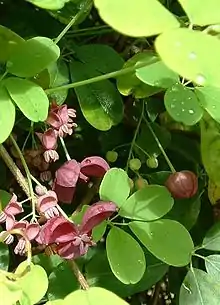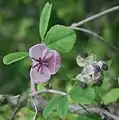Akebia quinata
Akebia quinata, commonly known as chocolate vine, five-leaf chocolate vine,[1] or five-leaf akebia, is a shrub that is native to Japan, China and Korea, and invasive in the eastern United States from Georgia to Michigan to Massachusetts.[2][3][4]
| Akebia quinata | |
|---|---|
 | |
| Scientific classification | |
| Kingdom: | Plantae |
| Clade: | Tracheophytes |
| Clade: | Angiosperms |
| Clade: | Eudicots |
| Order: | Ranunculales |
| Family: | Lardizabalaceae |
| Genus: | Akebia |
| Species: | A. quinata |
| Binomial name | |
| Akebia quinata | |
| Synonyms | |
|
Rajania quinata Houtt. | |
Description
Akebia quinata grows to 10 m (30 ft) or more in height and has compound leaves with five leaflets. The flowers are clustered in racemes and are chocolate-scented, with three or four sepals. The fruits are sausage-shaped pods which contain edible pulp.[2][5] The gelatinous placentation contains seeds surrounded with white pulp, that has a sweet flavor.
Local names
In China, A. quinata is referred to as 木通 – mù tōng (Pinyin) or mu tung (Wade-Giles) – meaning "woody thoroughgoing (plant)". It is also occasionally known as 通草 – tōng cǎo (Pinyin) or tung tsao (Wade-Giles) – meaning "thoroughgoing grass".
Uses
The fruit contains a sweet soft pulp resembling a white dragonfruit, eaten primarily in Japan as a seasonal delicacy. The rind, with a slight bitter taste, is used as vegetable, e.g., stuffed with ground meat and deep-fried. The vines are traditionally used for basket-weaving.[6]
The stem contains approximately 30% potassium salts thus causing a diuretic action.[7]
Cultivation
Akebia prefers sandy soils with good drainage, and regular watering, though it is drought-resistant.[8] In some areas the plant is an invasive species to be avoided.[9][10]
Etymology
'Akebia' comes from the Japanese vernacular name, 'akebi' (アケビ).[11]
'Quinata' means 'divided into five', and is presumably a reference to its lobed leaves.[11]
Gallery
 Female flower and 5 male flowers in Mount Ibuki
Female flower and 5 male flowers in Mount Ibuki Fruit
Fruit Sketch
Sketch flower parts
flower parts
Fun Facts
The Milkfruit used in the animated show "The Dragon Prince" is based on this vine.
See also
References
- English Names for Korean Native Plants (PDF). Pocheon: Korea National Arboretum. 2015. p. 345. ISBN 978-89-97450-98-5. Archived from the original (PDF) on 25 May 2017. Retrieved 25 January 2016 – via Korea Forest Service.
- Levy-Yamamori, Ran; Ran Levy; Gerard Taaffe (2004). Garden Plants of Japan. Timber Press. ISBN 0-88192-650-7. Retrieved 2009-04-05.
- "Akebia quinata". Flora of China. Retrieved 2009-04-05.
- "Flora of North America vol 3". Efloras.org. Retrieved 2018-05-31.
- "Decaisne, Joseph. Archives du Muséum d'Histoire Naturelle 1: 195, pl. 13a. 1839". Biodiversitylibrary.org. 2013-05-30. Retrieved 2018-05-31.
- taken from ja:アケビ (2011.11.3(Thu) 12:08)
- Reid, Daniel (2001), "A Handbook of Chinese Healing Herbs", Tuttle Publishing, ISBN 962-593-988-1. Retrieved on 2009-05-20.
- https://www.gardenia.net/plant/akebia-quinata-chocolate-vine
- https://davesgarden.com/guides/pf/go/369
- https://www.thespruce.com/grow-chocolate-vine-1316033
- Gledhill, David (2008). "The Names of Plants". Cambridge University Press. ISBN 9780521866453 (hardback), ISBN 9780521685535 (paperback). pp 40, 324
External links
| Wikimedia Commons has media related to Akebia quinata. |
- https://www.invasiveplantatlas.org/subject.html?sub=10090
- Akebia quinata (Houtt.) Dcne. (ITIS)
- Akebia quinata (Houtt.) Decne. Medicinal Plant Images Database (School of Chinese Medicine, Hong Kong Baptist University) (in Chinese) (in English)